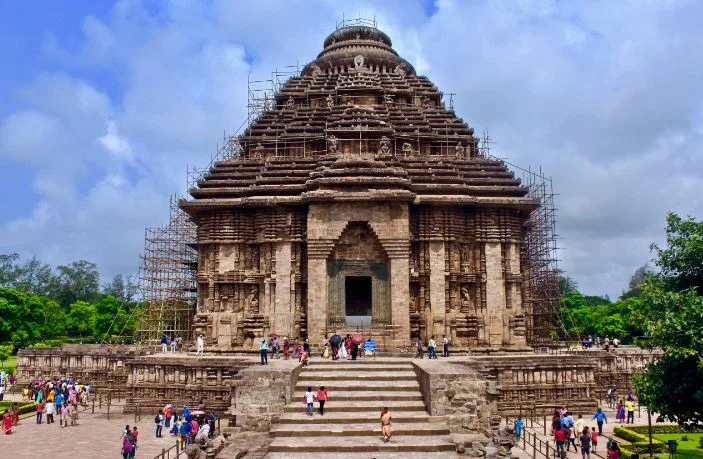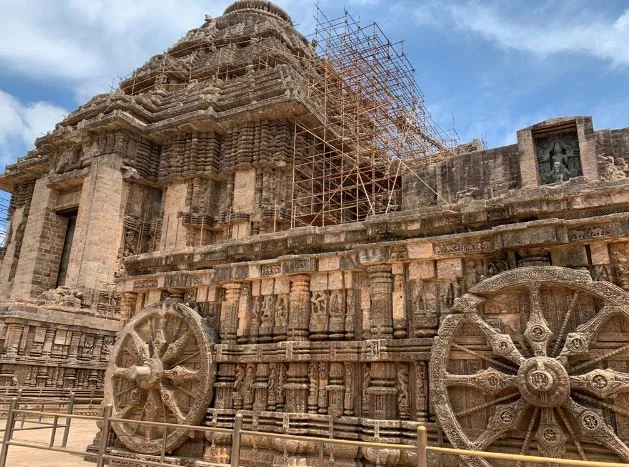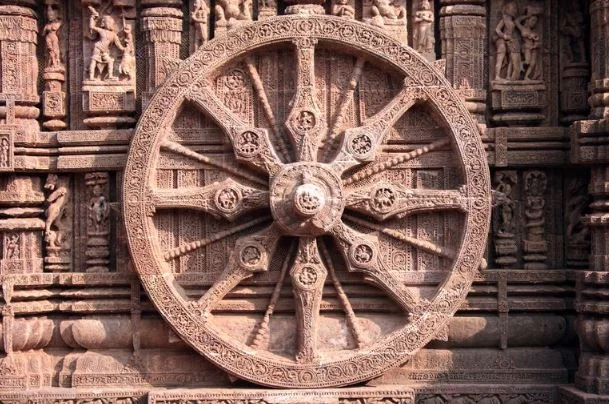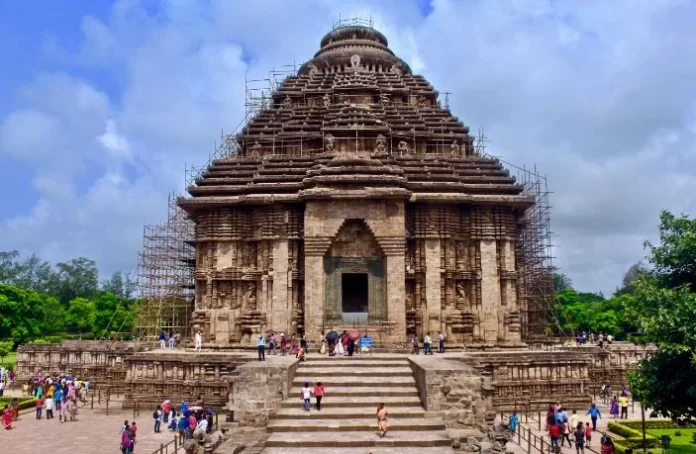Konark Sun Temple is a UNESCO World Heritage Site and is celebrated for its architectural brilliance. Here are 16 Facts About Konark Sun Temple.
The Konark Sun Temple is a magnificent Hindu temple dedicated to the Sun God, located in the town of Konark in the Puri district of Odisha, India.
The temple’s location is on the shores of the Bay of Bengal, approximately 35 kilometers northeast of Puri. The serene surroundings and the architectural grandeur of the temple make it a popular tourist destination. Now let’s see an article that consists of 16 facts about the Konark Sun Temple.
Facts About Konark Sun Temple

Here are 16 interesting Facts about Konark Sun Temple.
1. Historical Facts about Konark Sun Temple
The temple was built in the 13th century by King Narasimhadeva I of the Eastern Ganga dynasty. It is designed in the shape of a colossal chariot with intricately carved stone wheels, pillars, and walls.
The entire temple complex is adorned with intricate sculptures depicting various mythological scenes, celestial beings, and human figures.
- The Konark Sun Temple is a UNESCO World Heritage Site located in Konark, Odisha, India.
- It was built in the 13th century by King Narasimhadeva I of the Eastern Ganga dynasty.
- The temple is dedicated to the Sun God, Surya, and served as a center for religious worship and astronomical observations.
- The architectural marvel of the temple reflects the artistic and cultural brilliance of the ancient Kalinga Empire.
- Konark Sun Temple is considered one of the finest examples of medieval temple architecture in India.
2. Architectural Facts about Konark Sun Temple
Konark Sun Temple is known as one of the finest examples of Kalinga architecture and is dedicated to Lord Surya, the Sun God. It is believed that the temple was designed to capture the first rays of the rising sun.
- The temple is designed in the form of a gigantic chariot of the Sun God, with 24 intricately carved stone wheels representing the 24 hours of the day.
- The temple structure consists of three main components: the sanctum sanctorum (Garbhagriha), the assembly hall (mandapa), and the dance hall (natya mandapa).
- The main temple is adorned with exquisite stone carvings depicting various mythological and cultural scenes.
- The entire temple complex is aligned in an east-west direction to capture the first rays of the rising sun.
3. Konark as a Celestial Chariot

The Sun Temple in Konark is symbolic of the Sun God’s celestial chariot, driven by seven horses, representing the days of the week.
The temple’s wheels act as sundials, accurately calculating time-based on the position of the sun’s rays.
The architectural brilliance of the temple creates a harmonious fusion of science, art, and spirituality.
4. Intricate Stone Carvings
The Konark Sun Temple is renowned for its intricate stone carvings, depicting celestial beings, mythical creatures, dancers, musicians, and deities.
The carvings showcase the mastery of artisans in capturing the intricacies of human forms, emotions, and detailed ornamentation.
The temple walls are adorned with intricate motifs, such as floral designs, geometric patterns, and scenes from daily life.
The sculptures narrate stories from Hindu mythology, including the Ramayana, Mahabharata, and various Puranas.
5. Symbolism and Iconography
The Konark Sun Temple’s architectural elements and sculptures are rich in symbolism and iconography.
The chariot structure represents the cycle of life, with the Sun God driving the chariot across the celestial sphere.
The intricate carvings depict various gods, goddesses, celestial beings, and mythical creatures, each with its own symbolic significance.
The temple’s architecture and sculptures reflect the fusion of Hindu, Buddhist, and Jain influences prevalent during that era.
The entire temple complex is a visual representation of the cosmology, mythology, and religious beliefs of ancient India.
6. Konark Dance Festival
The Konark Dance Festival is an annual cultural event held in the temple complex, showcasing classical and traditional dance forms.
- Renowned dancers and troupes from all over the country participate in the festival, mesmerizing audiences with their performances.
- The festival celebrates the rich heritage of Indian classical dance and provides a platform for artists to showcase their talent.
- The open-air auditorium in the temple complex creates a unique ambiance for the performances, adding to the cultural significance of the event.
- The festival draws a large number of art lovers, enthusiasts, and tourists from around the world.
7. Ruins and Restoration Facts about Konark Sun Temple

Over the centuries, the Konark Sun Temple suffered significant damage due to natural calamities, foreign invasions, and neglect.
- In the 19th century, the temple’s main structure partially collapsed, leaving behind a majestic ruin.
- Efforts have been made by the Archaeological Survey of India (ASI) to restore and preserve the temple complex.
- Several restoration projects have been undertaken to stabilize the remaining structures, repair carvings, and prevent further deterioration.
The ongoing restoration work aims to safeguard the temple’s architectural splendor for future generations.
8. Maritime Trade and Influence
Konark, situated on the coast of the Bay of Bengal, played a significant role in maritime trade during ancient times.
- The temple’s proximity to the sea facilitated trade and cultural exchanges with foreign merchants and travelers.
- The architectural style of the temple exhibits influences from Southeast Asian and South Indian art and architecture.
- The temple complex served as a cultural hub, attracting scholars, artisans, and pilgrims from different parts of the world.
The maritime trade and cultural interactions associated with Konark contributed to the region’s prosperity and enriched its cultural heritage.
9. Konark is UNESCO World Heritage Site
The Konark Sun Temple was designated as a UNESCO World Heritage Site in 1984.
- It is recognized for its outstanding universal value, architectural brilliance, and historical significance.
- The UNESCO inscription highlights the temple’s cultural and artistic significance in the context of human civilization.
- The designation has led to increased recognition, conservation efforts, and tourism promotion for the temple and its surrounding areas.
10. Konark Beach
Konark Beach, located near the Sun Temple, is a popular tourist attraction.
The beach offers breathtaking views of the Bay of Bengal and is known for its golden sands and serene surroundings.
Tourists and visitors often visit the beach to relax, enjoy water sports, and witness mesmerizing sunrises and sunsets.
The beach also provides an opportunity to explore local handicraft stalls, enjoy local cuisine, and experience the coastal culture of Odisha.
11. Konark Museum
The Konark Museum, located near the temple complex, houses a rich collection of sculptures, artifacts, and archaeological remains.
The museum offers insights into the history, architecture, and artistic heritage of the Sun Temple and the surrounding region.
Visitors can explore various exhibits, including miniature replicas of the temple, ancient sculptures, and historical artifacts.
The museum serves as an educational resource and plays a crucial role in preserving and promoting the cultural legacy of Konark.
12. Spiritual Facts about Konark Sun Temple
The Konark Sun Temple holds immense spiritual significance for devotees and followers of the Sun God, Surya.
- It is believed that offering prayers and seeking the blessings of the Sun God at the temple brings prosperity, health, and spiritual enlightenment.
- The temple’s serene environment and architectural grandeur create a conducive atmosphere for meditation and introspection.
- Devotees visit the temple to pay homage to the Sun God and seek solace, inner peace, and divine intervention in their lives.
The temple’s spiritual aura and its association with the cosmic energy of the sun attract people from different faiths and backgrounds.
13. Konark Festival
The Konark Festival is a cultural extravaganza organized by the Odisha Tourism Department every year in December.
- The festival showcases classical dance and music performances by renowned artists from across the country.
- The performances take place in an open-air auditorium near the Sun Temple, creating a magical ambiance.
- The festival aims to promote Odisha’s rich cultural heritage and provide a platform for artists to showcase their talent.
The Konark Festival attracts a large number of tourists and art connoisseurs who appreciate the beauty of Indian classical arts.
14. Astronomical Facts about Konark Sun Temple

The Konark Sun Temple exhibits an advanced understanding of astronomy prevalent during its construction.
- The temple’s architecture and alignment are designed to capture the first rays of the rising sun during specific time periods.
- The temple’s sundial-like structures and carvings allow for accurate timekeeping and measurement of celestial movements.
- The intricate carvings of the temple also depict zodiac signs, celestial bodies, and astronomical events.
The temple’s astronomical features highlight the ancient Indian civilization’s scientific and astronomical achievements.
15. Influence on Indian Art and Architecture
The architectural style of the Konark Sun Temple has had a profound impact on Indian art and architecture.
- The temple’s distinct Kalinga style of architecture, characterized by intricate carvings, ornate motifs, and towering structures, has inspired subsequent temple constructions.
- The temple’s unique chariot-like design and sculptural details have influenced the architectural traditions of Odisha and other regions of India.
- The artistry and craftsmanship displayed in the temple’s sculptures have served as a benchmark for future generations of artisans and sculptors.
The Konark Sun Temple stands as a testament to India’s rich artistic heritage and continues to inspire artists and architects to this day.
16. Tourist Attraction and Cultural Heritage
The Konark Sun Temple is a major tourist attraction, drawing visitors from all around the world.
- Its architectural splendor, historical significance, and spiritual aura make it a must-visit destination for art lovers, history enthusiasts, and pilgrims.
- The temple complex and its surroundings offer a glimpse into ancient Indian civilization, its cultural traditions, and artistic brilliance.
- The temple’s inclusion in the list of UNESCO World Heritage Sites has further enhanced its global recognition and appeal.
The Konark Sun Temple stands as a proud symbol of India’s cultural heritage and serves as a reminder of the country’s glorious past.
Related Posts
- 21 Facts About Vaishno Devi
- 19 Facts About Amarnath
- 21 Facts About Kedarnath
- 27 Facts About Badrinath
- 16 Facts About Gangotri
- 17 Facts About Yamunotri
